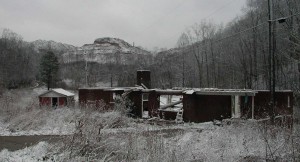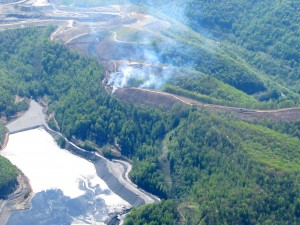- Like
- Digg
- Del
- Tumblr
- VKontakte
- Buffer
- Love This
- Odnoklassniki
- Meneame
- Blogger
- Amazon
- Yahoo Mail
- Gmail
- AOL
- Newsvine
- HackerNews
- Evernote
- MySpace
- Mail.ru
- Viadeo
- Line
- Comments
- Yummly
- SMS
- Viber
- Telegram
- Subscribe
- Skype
- Facebook Messenger
- Kakao
- LiveJournal
- Yammer
- Edgar
- Fintel
- Mix
- Instapaper
- Copy Link
On Tuesday, WV Agriculture Commissioner Walt Helmick made a pitch to the WV House Committee on Agriculture. He’d like to see hog farms on inactive mountaintop removal sites.
Helmick’s comments give some telling insight into both mountaintop removal operations and hog “farms.”
According to a WV Public Radio news story,
Helmick says the old mountaintop removal sites can’t grow crops, but that hog farming could bring in a great deal of profit.
To further his case, Helmick brought in examples of the pork industry in North Carolina.
“When you’re looking at the pork industry, which down in North Carolina, is a $2.5 billion industry,” said Helmick, “and that’s huge, about 30,000 direct jobs. $2.5 billion in one product and that’s the pork industry.”
Helmick says West Virginia can do better than North Carolina.
“We’re situated better than North Carolina,” explained Helmick, “We’re situated to the growing market of Indiana, Illinois, Kentucky, than they are. And so they understand that we do have the rails, the three phase electricity, that we also have water, and we have the remoteness that a lot of industries want. Those areas are remote because you had mining activity. Couldn’t have anybody live within 5 or 6 miles of the place, and so those are very positive things for us.”
That there’s water (at least clean, healthy water) on top of or near mountaintop removal sites is highly arguable (for starters check out these studies: Bernhardt and Palmer, Hitt, Duke, and KU), but the telling parts of what Helmick says include his out-loud utterance that MTR sites are not suitable for growing crops. (However, hemp may be a possibility…?)
 Helmick says another thing that government officials have avoided saying out loud: MTR mining activity makes places remote. From our experience, that’s because people have been driven away by the approaching mining. Helmick likely overstated himself and knows that there are some people and communities still near some MTR sites, but the folks living near MTR sites are far more likely to be unhealthy and facing early death than people who don’t live near MTR sites.
Helmick says another thing that government officials have avoided saying out loud: MTR mining activity makes places remote. From our experience, that’s because people have been driven away by the approaching mining. Helmick likely overstated himself and knows that there are some people and communities still near some MTR sites, but the folks living near MTR sites are far more likely to be unhealthy and facing early death than people who don’t live near MTR sites.
The other telling bit here is that people don’t want to live near hog farms. The “pew” factor is horrendous, as is the potential for water pollution. If we are in fact going to do better than North Carolina, maybe we could start by doing what that state did in 2007 — let’s ban hog slurry lagoons now, before we have them. (Not that such a law is doing NC any good… Maybe that 2007 law was repealed or not enforced like so many laws here, or maybe there was some linguistic detoxification that makes hog farm waste “cells” instead of lagoons.)
Gee what a grand idea, not: Let’s give the area already suffering from MTR-water pollution and coal slurry “lakes” some hog slurry lagoons. Not to mention the massive cruelty associated with factory farms…
Can’t we come up with something a little more positive for those old MTR sites, such as solar farms (we sure won’t have to worry about trees getting shading solar collectors)? There’s also the proposal about bee hives on old MTR sites (be sure to test the honey for pollutants).
Whatever happens on old MTR sites (that continue to spew pollution decades after they are “reclaimed”), it’s way past time to end MTR. Not one more square inch of new MTR mines. Please make plans now to come out on March 16 and tell DEP just that. And be sure to encourage your state’s delegation to support the ACHE Act.










So what he is talking about is industrial sized hog farming…with all its associated environmental problems…not to mention the inhumane treatment of the animals. While people across the country are calling for an end to these cruel practices, once again WV state leaders look to embrace an industry that has horrible impacts on communities (and water), not to mention causing horrible suffering of animals.
“Helmick says the old mountaintop removal sites can’t grow crops” and he mentions water – does he know how polluted that water is likely to be?
Ick! I am visualizing a lake of hog manure, urine and – probably – blood on top of a mtr site… and those poor animals suffering in those cramped cages inside warehouse type buildings… just gross! This would definitely make a vegetarian out of me!
I do think it’s just bacon-smelling smoke that he’s blowing, though; how in the world would they get enough water and other infrastructure (roads, etc) up on most mtr sites to make a large scale hog farm feasible?
I agree; it is way past time for MTR to end! And, for our elected leaders to stop looking for increasingly bogus and nasty justifications for keeping these operations going.If our hills and stream ecosystems are kept intact, many local farmers could raise hogs in a very humane and sustainable way – with access to natural vegetation and food and clean water – for the growing organic and local foods market outlets in this state and region.
I doubt Helmick or the hog industry care if they feed their hogs toxic water or that their hogs will root in toxic soil. Mountaintop removal has stigmatized S WV as an industrial sacrifice zone. If its not hogs its going to be something else just as bad. I’ve been seeing MTR permit revisions on reclamation being approved for grasslands, meaning anything that will grow. These MTR sites have a myriad of roads already connecting them to county roads and highways, a railway system is in place. MTR is going to be over, the coal industry is planning its exit strategy, they don’t want the expense of retiring a sludge dam, these dams can be used for hog sludge also, its the perfect exit. The politicians are searching for new pockets of cash, the people in these communities have historically been shit on, why not send them some hog business for jobs. Their water and air is already fouled, no other industry is going to set up shop there, but the hog industry needs places to expand and MTR communities offer the least resistance.
Nothing, NOTHING can make mtr lands useful in any sense. Would pig manure even break down in that toxic brew of sludge and highly polluted water? What about the costs of shipping in feed? What about the heat of Summer, the freeze of Winter and the howl of the winds on the barren and unprotected plains? What about the pig guts if slaughtered here? What about the stench of stock trucks taking them elsewhere? A five mile radius zone of no human habitation? That takes up a large amount of land, especially if this idea takes off. And what kind of jobs and wages would the workers get after driving their five miles plus (gotta have a car which not everyone can afford). Surely shitty (!!!!!) jobs at minimum wages. I see no upside here.
I was born here in W.V. (Charleston)and now live in the “Southern Coalfields”. I do not think there has ever been anything to come close to the devastation of MTR! I agree maybe Industrial Hemp would have a snowballs chance of even trying to save or even trying to reclaim the Disaster sites of MTR. Call me Extreme because you do it for a living. My grandfathers and all my moms brothers were coal-miners so don’t try and say “oh no! She is just another tree hugging hippie”. Thank you to everyone that knows MTR needed to be stopped before it ever started destroying our beautiful State! Out of State Extreme Extractions Industries are at fault. I agree with the others here. Nothing will work on those sites and it will be a miracle to get any growth on those sites at all! Wake up WV.